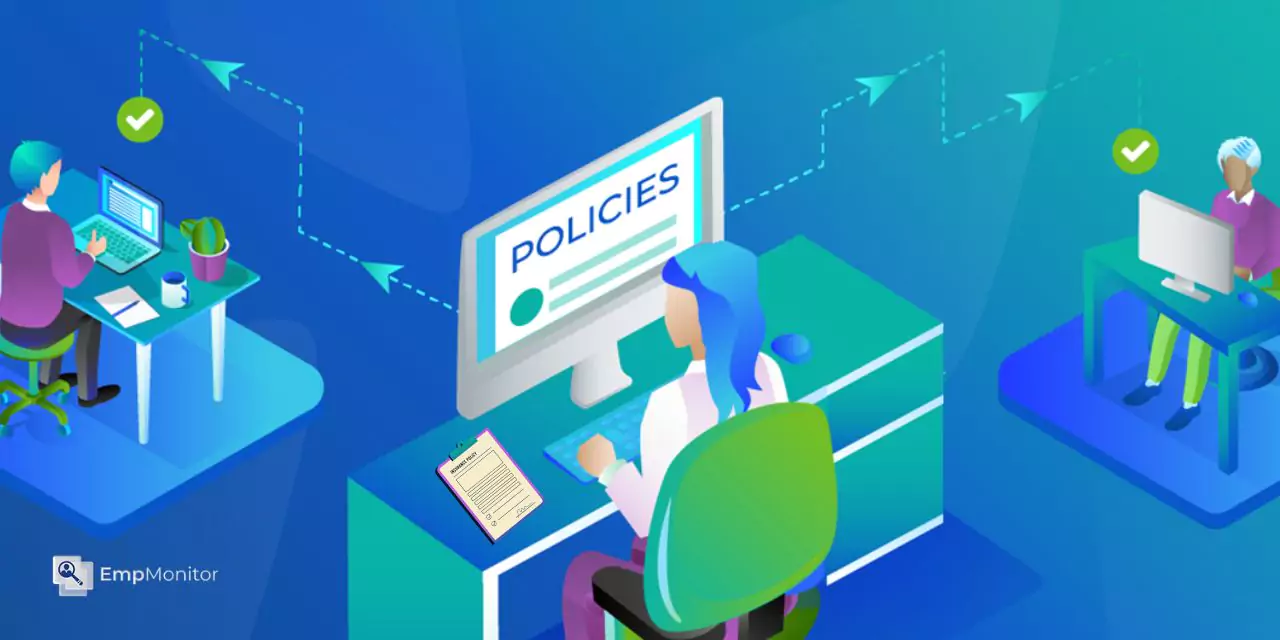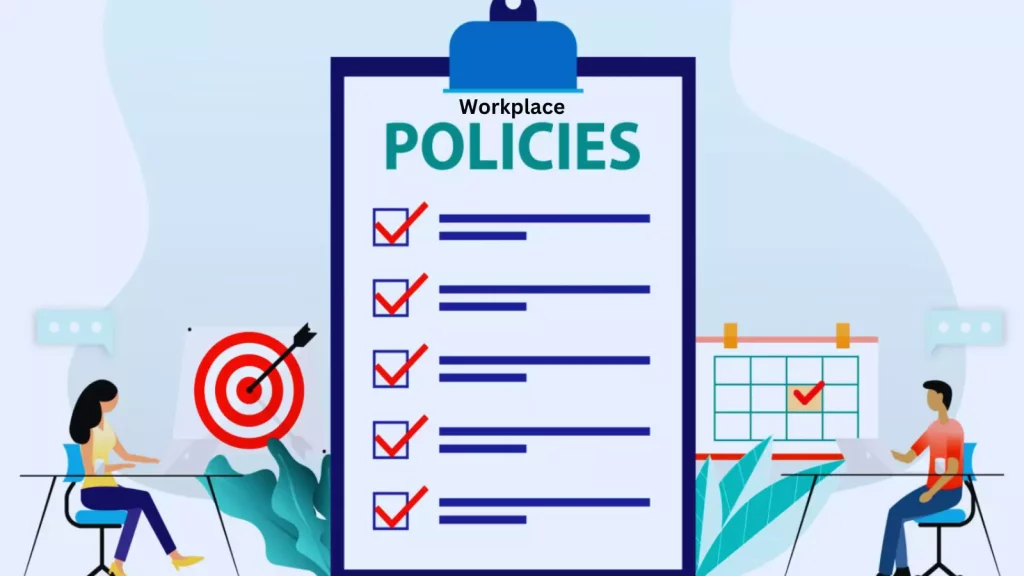In the dynamic modern workplaces, rules and regulations govern nearly every aspect of our professional lives. From punctuality to communication protocols, workplace policies serve as the framework that shapes our interactions, expectations, and ultimately, our success within an organization. Yet, despite their importance, navigating these policies can often feel like deciphering a complex, leaving many employees uncertain about what is expected of them.
Understanding employee policies is not just about compliance; it’s about fostering a culture of clarity, mutual respect, and productivity. Following workplace policies properly, organizations can safeguard their interests and contribute to a harmonious and productive work environment.
So, whether you’re seeking clarity on existing policies or preparing to embark on a new career path, join us as we unravel the mysteries of workplace policies and empower you to thrive in any professional setting.
IN A HURRY? LISTEN TO THE BLOG INSTEAD!
What Is A Workplace Policy?
A workplace policy is a set of guidelines, rules, and procedures established by an organization to govern various aspects of work-related behavior, practices, and expectations.
These policies are designed to outline acceptable and unacceptable conduct, promote consistency, ensure compliance with legal requirements, and maintain a safe and respectful work environment for all employees.
Organizational policies typically are acceptable use policies for workplace technology. It covers a wide range of areas, including employee conduct, health and safety protocols, discrimination and harassment prevention, confidentiality, use of company resources, attendance and leave policies, and more.
They serve as a framework for decision-making, provide clarity on organizational expectations, and help mitigate risks associated with potential conflicts or legal issues.
Why Are Workplace Policies Important?
Workplace policies are important for several reasons:
- Clarity and Consistency: They provide clear guidelines and expectations for employees, reducing confusion and promoting consistency in decision-making and behavior across the organization.
- Legal Compliance: Workplace policy helps ensure that the organization complies with relevant laws and regulations, reducing the risk of legal liabilities and penalties.
- Employee Protection: They outline rights, responsibilities, and protections for employees, such as policies against discrimination, harassment, and unsafe working conditions, fostering a safe and respectful workplace environment.
- Risk Management: Policies help mitigate risks associated with various workplace issues, such as data breaches, conflicts of interest, safety hazards, and misconduct, protecting the organization’s reputation and assets.
- Promoting Organizational Values: Organizational policies reflect the values, culture, and expectations of the organization, reinforcing its commitment to ethical conduct, diversity, inclusion, and professionalism.
- Performance Management: They establish standards for performance, conduct, and accountability, providing a framework for evaluating and managing employee performance effectively. Utilizing tools like EmpMonitor enhances tracking and assessment processes, ensuring optimal performance management.
- Conflict Resolution: Policies offer guidance on handling disputes, grievances, and disciplinary actions fairly and consistently, reducing the likelihood of conflicts escalating and impacting productivity.
- Employee Well-being: Certain policies, such as those related to health and safety, work-life balance, and wellness programs, contribute to the physical, mental, and emotional well-being of employees, enhancing morale and job satisfaction.
Workplace policies, combined with tools like EmpMonitor, play a crucial role in promoting fairness, ensuring compliance, and fostering a positive and productive work environment for employees and the organization as a whole.
EmpMonitor, when integrated with workplace policies, becomes an essential tool for promoting fairness, compliance, and productivity. It facilitates equitable enforcement of guidelines by tracking employee activities. This combination fosters a positive work environment by empowering employees to self-monitor, enhancing accountability, and driving productivity.
By providing insights into performance metrics, EmpMonitor aids in identifying areas for improvement and refining policies to meet evolving organizational needs. Ultimately, this partnership between EmpMonitor and workplace policies not only ensures a level playing field for all employees but also strengthens the organization’s overall compliance and efficiency.
EmpMonitor: Employee Monitoring Software
EmpMonitor is an advanced user activity monitoring tool designed to enhance productivity, efficiency, and security- in the workplace. EmpMonitor can significantly assist in enforcing and upholding company policies by providing comprehensive monitoring and tracking capabilities. Here’s how:
- Employee Monitoring: EmpMonitor allows employers to monitor employee activities to ensure compliance with workplace policies regarding internet usage, data security, and confidentiality. By tracking activities such as website visits, application usage, and document access, employers can identify any violations and take appropriate action.
- Project Management: Make planning easier, assign tasks effortlessly, and work together in real time. Keep track of progress and time spent, ensuring resources are used wisely. This feature of EmpMonitor simplifies workflow, tracks progress, assigns resources accurately, and encourages teamwork.
- Remote Monitoring: With the increasing prevalence of remote work, EmpMonitor can extend its monitoring capabilities to remote employees’ devices. This allows organizations to enforce workplace policies consistently across both office-based and remote work environments.
- Performance Evaluation: EmpMonitor can contribute valuable data for performance evaluations by providing insights into employee behavior, work habits, and adherence to policies. Managers can use this information to provide feedback, set performance goals, and recognize exemplary behavior in line with company policies.
EmpMonitor serves as a valuable tool for enforcing workplace policy, promoting a culture of compliance, and mitigating risks associated with policy breaches. By providing insights into employee behavior and activity, EmpMonitor empowers employers to maintain a secure, efficient, and policy-compliant work environment.
Different Types Of Workplace Policies
There are various types of workplace policies that organizations may implement to govern different aspects of the work environment. Some common types of workplace policies include:
- Code of Conduct Policy: This policy outlines the expected standards of behavior and ethics for employees monitoring within the workplace. It typically covers areas such as professionalism, respect, integrity, confidentiality, and compliance with laws and regulations.
- Equal Employment Opportunity (EEO) Policy: An EEO policy prohibits discrimination and promotes equal opportunities for all employees regardless of race, gender, age, religion, disability, or other protected characteristics. It ensures fair treatment in hiring, promotion, compensation, and other employment practices.
- Health and Safety Policy: Health and safety policies establish guidelines and procedures to ensure a safe and healthy work environment for employees. They cover areas such as accident prevention, emergency procedures, hazard identification and mitigation, and employee responsibilities for safety.
- Anti-Harassment and Anti-Discrimination Policy: These policies prohibit any form of harassment or discrimination based on protected characteristics such as race, gender, sexual orientation, religion, disability, or age. They outline procedures for reporting and addressing complaints and promote a respectful and inclusive workplace culture.
- Attendance and Leave Policy: Leave and attendance policies define expectations regarding attendance, punctuality, and various types of leave, including vacation, sick leave, and parental leave. They ensure consistency in managing absences and provide guidelines for requesting and approving leave.
- Internet and Technology Usage Policy: This policy governs the acceptable use of company-provided technology resources, including computers, internet usage access, email, and software. It establishes guidelines for appropriate use, security measures, privacy considerations, and consequences for violations.
These are the common types of workplace policies that are essential for promoting fairness, safety, compliance, and productivity within organizations. They provide clear guidelines and expectations for employees and help create a positive and respectful work environment.
How To Draft And Implement A Workplace Policy?
When crafting a workplace policy, follow these steps to ensure it’s effective and aligned with your organization’s needs:
Step 1: Identify The Need
Consider your workforce’s demographics, working hours, locations, and industry. Tailor your policy to meet the specific needs and circumstances of your employees. For instance, if your business operates in a regulated sector, prioritize areas like security and anti-bribery.
Step 2: Research Legal Requirement
Familiarize yourself with federal and state laws relevant to your industry and workforce. Ensure that your policy complies with all applicable regulations and stays updated with any legal changes. Consider subscribing to employment law updates to stay informed.
Step 3: Conduct Thorough Research and Consider Legal Review
Before finalizing your policy, make sure you do thorough research on the topic. Look into HR policies, free resources, and employment law lectures. You can also find templates or drafts online to help you get started.
Even if you know your business well, it’s always a good idea to have someone else review your policy. Consider asking an external legal or HR expert to check it over. While this might cost money upfront, it could save you money in the long run if your policy is ever challenged legally, like in disciplinary cases or when a certain policy is required by law.
Step 4: Rollout and Implementation
Schedule a meeting with managers to introduce the new policy and address any questions or concerns they may have. Provide them with a copy in advance to review. Incorporate any feedback or suggestions from the managers before finalizing the policy. Once approved, communicate the policy to all employees and ensure they understand its contents and implications.
By following these steps, you can draft and implement a workplace policy that effectively addresses your organization’s needs while ensuring legal compliance and employee understanding.
Here are some common workplace policies examples:
- Equal Employment Opportunity Policy: Ensures fair treatment of all employees and prohibits discrimination based on factors such as race, gender, age, religion, disability, or sexual orientation.
- Code of Conduct/Ethics Policy: Set expectations for ethical behavior, integrity, and professionalism in the workplace, including guidelines for conflicts of interest, confidentiality, and honesty.
- Anti-Harassment and Anti-Discrimination Policy: Prohibits harassment, bullying, and discrimination in any form and outlines procedures for reporting and addressing complaints.
- Workplace Health and Safety Policy: Establishes guidelines and procedures to ensure a safe and healthy work environment, including protocols for accident reporting, emergency preparedness, and hazard communication.
- Remote Work Policy: For work-from-home policy establishes guidelines, expectations, and procedures for employees who work remotely, including eligibility criteria, communication protocols, and performance measurement standards.
These are just a few examples, and workplace policies may vary depending on the organization’s industry, size, and specific needs. To simplify this process, tools like a remote work policy generator can help organizations quickly create customized policies tailored to their workforce. It’s important for organizations to regularly review and update their policies to ensure compliance with legal requirements and alignment with the company’s values and objectives.
ALSO READ:
Efficient Internet Usage Policy To Set Employees Up For Success
7 Considerations To Implement Work From Home Policy During The Pandemic
How To Maintain Employee Monitoring Ethics At Workplace
How To Develop A Call Out Policy for Your Business: Step-By-Step Guide
Mastering Workplace Policies: Employees Tips
- Read Thoroughly: Take time to go through the employee handbook or any provided documents to understand company policies comprehensively.
- Ask Questions: Don’t hesitate to seek clarification from HR or supervisors if any policy is unclear.
- Stay Updated: Be aware of any changes in policies to avoid unintentional violations.
- Consistency Matters: Ensure fair and consistent implementation of policies to maintain a positive work environment.
- Know the Purpose: Understand why policies are in place, whether for legal compliance, safety, or maintaining a respectful workplace.
- Follow Codes of Conduct: Adhere to guidelines on behavior, ethics, and professionalism set by the company.
- Contribute to Compliance: Play your part in upholding policies to protect both yourself and the organization.
- Seek Support: If in doubt, seek guidance from HR or relevant departments to ensure compliance and understanding.
Wrapping Up
To do well at work, it’s important to know the rules. Begin by reading the employee handbook carefully to understand things like when you need to be at work, how you should behave, and how to keep things private. If you’re unsure about anything, don’t be afraid to ask questions to get clear answers. Stay updated on policy changes to avoid unintentional violations. Consistency in implementing policies ensures fairness and fosters a positive work environment.
Additionally, utilizing tools like EmpMonitor can help in tracking adherence to policies and ensuring compliance, enhancing overall productivity and efficiency.
Remember, these policies exist to protect both you and the company. By adhering to them, you contribute to a harmonious workplace. With these tips, navigating workplace policies becomes simpler, enabling you to thrive in your role.













